Sony F3232021 Mobile Broadband USB Modem User Manual MD300 USEGUIDE
Sony Mobile Communications Inc Mobile Broadband USB Modem MD300 USEGUIDE
Sony >
User Manual
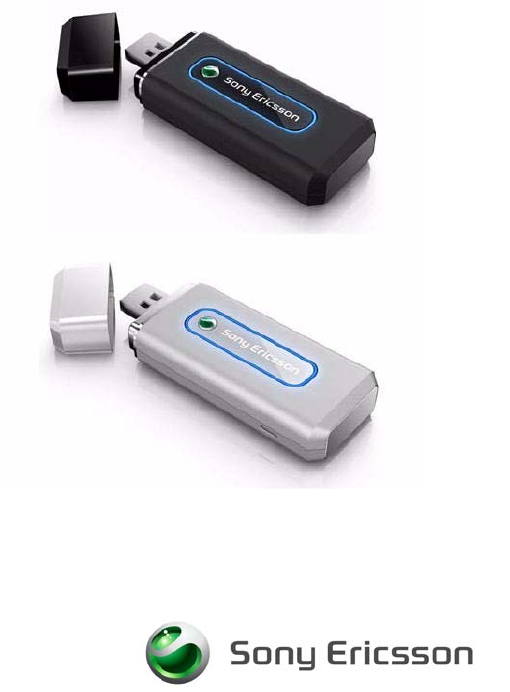
Mobile Broadband USB Modem
MD300 HSDPA/UMTS/EDGE
User Guide
DRAFT
ii Contents
Contents
Contents . . . . . . . . . . . . . . . . . . . . . . . . . . . . . . . . . . . . . . . . . . . . . ii
Regulatory information . . . . . . . . . . . . . . . . . . . . . . . . . . . . . . . . . v
Declaration of conformity . . . . . . . . . . . . . . . . . . . . . . . . . . . . . . . . . . . . . . v
FCC statement . . . . . . . . . . . . . . . . . . . . . . . . . . . . . . . . . . . . . . . . . . . . . . vi
Industry Canada Statement . . . . . . . . . . . . . . . . . . . . . . . . . . . . . . . . . . . . vi
About this guide. . . . . . . . . . . . . . . . . . . . . . . . . . . . . . . . . . . . . . . vii
How this guide is organised . . . . . . . . . . . . . . . . . . . . . . . . . . . . . . . . . . . . vii
Additional resources . . . . . . . . . . . . . . . . . . . . . . . . . . . . . . . . . . . . . . . . . . vii
Overview . . . . . . . . . . . . . . . . . . . . . . . . . . . . . . . . . . . . . . . . . . . . . 1
Checklist . . . . . . . . . . . . . . . . . . . . . . . . . . . . . . . . . . . . . . . . . . . . . . . . . . . 1
MD300 Communications Summary . . . . . . . . . . . . . . . . . . . . . . . . . . . . . . 1
MD300 Flash Drive . . . . . . . . . . . . . . . . . . . . . . . . . . . . . . . . . . . . . . . . . . . 2
Hardware overview. . . . . . . . . . . . . . . . . . . . . . . . . . . . . . . . . . . . . . . . . . . 2
Status LEDs . . . . . . . . . . . . . . . . . . . . . . . . . . . . . . . . . . . . . . . . . . . . . . . . 3
SIM Card. . . . . . . . . . . . . . . . . . . . . . . . . . . . . . . . . . . . . . . . . . . . . . . . . . . 3
Network and subscription requirements . . . . . . . . . . . . . . . . . . . . . . . . . . . 4
Configurations. . . . . . . . . . . . . . . . . . . . . . . . . . . . . . . . . . . . . . . . . . . . . . . 4
USB 1.1 and 2.0 . . . . . . . . . . . . . . . . . . . . . . . . . . . . . . . . . . . . . . . . . . . . . 8
Software overview . . . . . . . . . . . . . . . . . . . . . . . . . . . . . . . . . . . . . . . . . . . 9
System requirements . . . . . . . . . . . . . . . . . . . . . . . . . . . . . . . . . . . . . . . . . 10
Additional information. . . . . . . . . . . . . . . . . . . . . . . . . . . . . . . . . . 11
Guidelines for safe and efficient use. . . . . . . . . . . . . . . . . . . . . . . . . . . . . . 11
Generic SEMC Limited warranty . . . . . . . . . . . . . . . . . . . . . . . . . . . . . . . . 13
Technical specifications . . . . . . . . . . . . . . . . . . . . . . . . . . . . . . . . 16
Index . . . . . . . . . . . . . . . . . . . . . . . . . . . . . . . . . . . . . . . . . . . . . . . .21
DRAFT
Contents iii
Sony Ericsson MD300 Mobile Broadband USB Modem
First edition (January 2008)
This manual is published by Sony Ericsson Mobile Communications AB, without any warranty.
Improvements and changes to this manual necessitated by typographical errors, inaccuracies of
current information, or improvements to programs and/or equipment, may be made by
Sony Ericsson at any time and without notice. Such changes will, however, be incorporated into new
editions of this manual.
This manual is copyrighted work of Sony Ericsson Mobile Communications AB, Sweden.
The programs referred to herein are copyrighted and trademarked works of Sony Ericsson Mobile
Communications AB, Sweden. Reproduction in whole or in part, including utilisation in machines
capable of reproduction or retrieval, without the express written permission of the copyright holders
is prohibited. Reverse engineering is also prohibited.
Windows and Vista are registered trademarks or trademarks of Microsoft Corporation in the United
States and/or other countries.
Adobe and Reader are either registered trademarks or trademarks of Adobe Systems Incorporated in
the United States and/or other countries.
All other product or service names mentioned in this manual are trademarks of their respective
companies.
All rights reserved.
© Sony Ericsson Mobile Communications AB, 2008
Publication number: 1207-3842.1
DRAFT
iv Contents
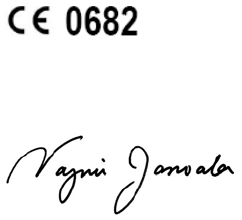
DRAFT
Regulatory information v
Regulatory information
Declaration of conformity
We, Sony Ericsson Mobile Communications AB of
Nya Vattentornet
S-221 88 Lund, Sweden
declare under our sole responsibility that our product
Sony Ericsson type FAD-3232021-BV
and in combination with our accessories, to which this declaration relates is in conformity with the
appropriate standards 3GPP TS 51.010-1, EN 301908-1, EN 301908-2, EN 301489-7, EN 301489-
24 and EN 60950, following the provisions of Radio Equipment and Telecommunication Terminal
Equipment directive 99/5/EC with requirements covering EMC directive 89/336/EEC, and Low
Voltage directive 73/23/EEC.
Research Triangle Park, North Carolina. March 2008
Place and date of issue
Najmi Jarwala
President - US & Canada
Sony Ericsson Mobile Communications (USA) Inc.
We fulfil the requirements of the R&TTE Directive (99/5/EC).

DRAFT
vi Regulatory information
FCC statement
FCC ID: PY7F3232021
IC: 4170B-F3232021
This equipment has been tested and found to comply with the limits for a Class B digital device,
pursuant to Part 15 of the FCC Rules. These limits are designed to provide reasonable protection
against harmful interference in a residential installation. This equipment generates, uses and can
radiate radio frequency energy and, if not installed and used in accordance with the instructions, may
cause harmful interference to radio communications. However, there is no guarantee that
interference will not occur in a particular installation. If this equipment does cause harmful
interference to radio or television reception, which can be determined by turning the equipment off
and on, the user is encouraged to try to correct the interference by one or more of the following
measures:
• Reorient or relocate the receiving antenna.
• Increase the separation between the equipment and receiver.
• Connect the equipment into an outlet on a circuit different from that to which the receiver is
connected.
• Consult the dealer or an experienced radio/TV technician for help.
WARNING: Changes or modifications made to this equipment not expressly approved by
Sony Ericsson Mobile Communications AB may void the FCC authorization to operate this
equipment.
CAUTION: The Sony Ericsson USB device has been tested for compliance with FCC/IC RF
exposure limits in the laptop computer(s) configurations with a USB port and can be used in laptop
computers with substantially similar physical dimensions, construction, and electrical and RF
characteristics.
Note: If this Sony Ericsson USB device is intended for use in any other portable device, you are
responsible for separate approval to satisfy the SAR requirements of Part 2.1093 of FCC rules.
Industry Canada Statement
This Class B digital apparatus complies with Canadian ICES-003.
Cet appareil numérique de la classe B est conforme à la norme NMB-003 du Canada.
F
C
c

DRAFT
About this guide vii
About this guide
Congratulations and thank you for purchasing a Sony Ericsson MD300 Mobile Broadband USB
Modem.
This guide includes an overview of the supported features, detailed technical specifications, system
requirements, and safety guidelines for your MD300.
Note:
Be sure to read all safety guidelines in this document before using your MD300.
How this guide is organised
Chapter 1: Overview on page 1, contains an overview of your MD300 and the features that it
supports. It also provides a list of the requirements and tools needed to use your new MD300.
Chapter 2: Additional information on page 11, provides safety guidelines, warranty information, and
regulations that are relevant to your MD300.
Chapter 3: Technical specifications on page 16, provides detailed technical specifications for your
MD300.
Additional resources
Sony Ericsson support Website
Additional resources can be found on the Internet at the Sony Ericsson support Website You can use
the Sony Ericsson Website to find the most up-to-date product information and support wherever
you are. It gives you access to online customer services, user manuals, the latest software downloads,
and other useful information. For more information, go to:
www.sonyericsson.com/support
Publications
Sony Ericsson provides the following documents to help you use your MD300:
• A printed Quick Start Guide aimed at getting you operational as quickly as possible.
• A PDF MD300 User Guide (this document) that contains a detailed description of your MD300
and the features that it supports. This document is copied to your hard drive when Wireless
Manager is installed and can be accessed by selecting Start All Programs Sony
Ericsson Wireless Manager 5 MD300 User Guide
•Online Help built into Wireless Manager which describes in detail how to use each feature and
how to install and uninstall the software. Select Help or press F1 to access online help.
• A PDF Wireless Manager User Guide which contains the same detailed information as the
online help in a conventional printable format. This document is available from the support
website only.
DRAFT
viii About this guide
Note:
PDF documents are in Adobe® Portable Document Format. If your PC cannot open these
documents, download and install the Adobe® Reader® from www.adobe.com.
Note:
Your mobile operator may provide alternative application software and documentation.

DRAFT
Overview 1
Overview
Checklist
The following items should be in the box when you unpack it:
• Sony Ericsson MD300 Mobile Broadband USB Modem
• USB extension cable
• Quick Start Guide (QSG)
• Mounting clip
MD300 Communications Summary
Your MD300 keeps you in touch, enabling you to use the best available mobile service wherever you
are. It supports tri-band UMTS and quad-band GSM:
Your MD300 supports SMS text messaging and the following communications services:
Where UMTS service with HSDPA is available, your MD300 can connect at speeds up to 3.6Mbps.
Your MD300 provides automatic fallback to UMTS where HSDPA is not available and to EDGE or
GPRS service where UMTS is not available (network support required). This section describes the
services that the MD300 supports:
• High Speed Downlink Packet Access (HSDPA)
HSDPA is an enhancement to UMTS networks which enables the downlink speed to be
dramatically increased; up to 3.6Mbps using the MD300. File downloads will be faster,
whilst applications such as video streaming may operate at higher quality and greater
reliability. The maximum speed available depends on the configuration of the mobile
network and local conditions such as distance to the base station.
• Universal Mobile Telecommunications System (UMTS)
UMTS is a 3G technology standard for wide-area wireless data communication that is based
on the GSM standard. The UMTS standard uses advanced network operator mobile Internet
GSM
GPRS
EDGE
850MHz
900MHz
1800MHz
1900MHZ
UMTS
HSDPA
850MHz
1900MHz
2100MHz
Service Maximum Download Speed Maximum Upload Speed
HSDPA 3.6Mbps 384kbps
UMTS 384kbps 384kbps
EDGE 247.4kbps 123.7kbps
GPRS 53.6kbps (CS-2)
85.6kbps (CS-4)
26.8kbps (CS-2)
42.8kbps (CS-4)
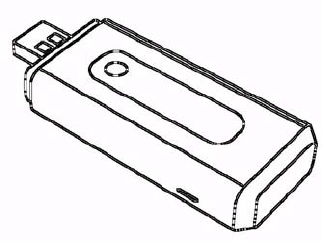
DRAFT
2Overview
services to achieve data transfer rates up to 384 kbps, which are ideal for media streaming,
video MMS, internet shopping, and banking.
• Enhanced Data Rates for Global Evolution (EDGE)
EDGE enhances GPRS by increasing data throughput over GPRS by as much as three times,
depending upon the network radio signal strength and quality. GPRS networks that are
enhanced with EDGE are often referred to as Enhanced GPRS (E-GPRS) networks.
EDGE provides the “always on” capability of GPRS but at faster speeds. EDGE technology
is transparent — simply make a GPRS connection as usual and benefit from the increase in
speed where EDGE is available in a network. When EDGE is available you can expect
increased speeds of up to 200 kbps, dependent on network coverage.
• General Packet Radio Service (GPRS)
GPRS is a type of network connection that provides “always on” mobility. The connection
set up is fast. After you are connected, applications can send and receive data whenever
required. In today’s GPRS networks, the MD300 receives data at speeds up to 53.6 kbps and
transmits at speeds up to 26.8 kbps.
• Short Message Service (SMS)
You can send and receive SMS text messages using the Text Messages window in Wireless
Manager or other application software.
MD300 Flash Drive
The MD300 may be used as a flash memory drive. Once the MD300 is installed and functioning as
a modem, you may use the memory space on the drive to store and transport your own files and
media.
Hardware overview
Your Sony Ericsson MD300 uses the 5 volt power supply provided by the USB port. USB devices
which draw more than 100mA from the port are known as High Power USB devices; the MD300
is a High Power device.
The amount of power that your MD300 draws from the PC (laptop battery when mobile) depends on
several factors, including status, frequency band, and distance to the base station that is used.
The MD300 can be turned off under software control from the Wireless Manager application or the
signal strength icon in the status tray. It is recommended that the user remove the modem from the
laptop when flying to prevent any accidental transmission.
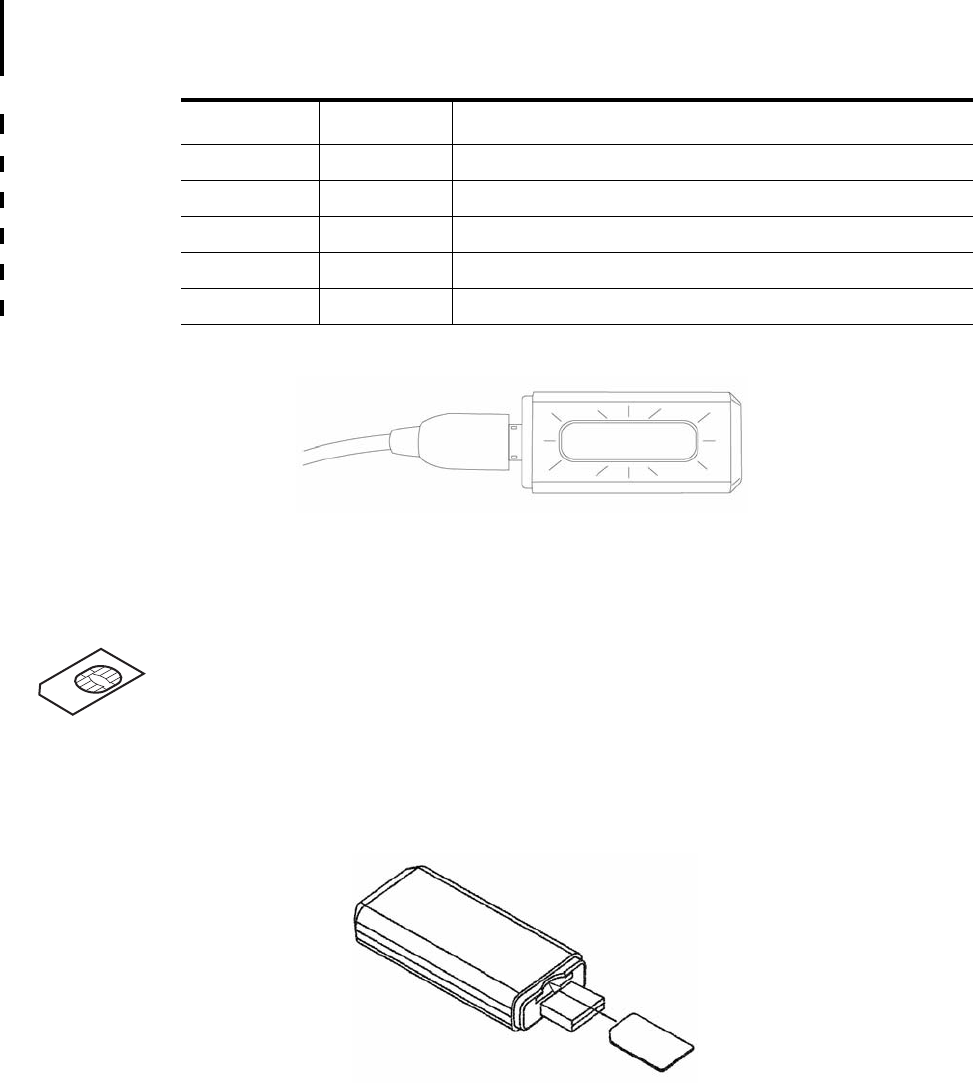
DRAFT
Overview 3
Status LEDs
The MD300 contains multi-colored LEDs that indicate the status of the device.
The LEDs illuminate around the Sony Ericsson logo, as shown below.
SIM Card
When you subscribe to a mobile network, you are issued a Subscriber Identity Module (SIM) card.
Your SIM card contains your personal subscriber data. To connect to a mobile network you must
first insert your SIM card that includes the appropriate network subscription into your MD300.
To insert the SIM card
The SIM card slot is spring loaded and the SIM card will click into place when properly inserted.
Insert the SIM card into the slot next to the USB connector of the MD300. Make sure the gold
contacts on the SIM card are facing towards the USB connector and the angled corner of the SIM
card is placed into the MD300 as shown. Push the SIM card into the MD300 until it clicks.
Note:
The SIM card will not click in place if it is inserted incorrectly.
To remove the SIM card
Push on the SIM card until it clicks and release.
Note:
Using a pen or jewelers screwdriver may help to push on the SIM card.
LED color Flash rate Description
Red Fast Searching for a mobile network
Green Medium Registered to GPRS or EDGE service, not connected
Green Slow Connected - GPRS or EDGE service
Blue Medium Registered to UMTS or HSDPA service, not connected
Blue Slow Connected - UMTS or HSDPA service
DRAFT
4Overview
The internal spring will push the SIM card out far enough for you to grasp the SIM card and pull the
it out of the MD300.
Network and subscription requirements
The network subscription you use in conjunction with your MD300 depends on the functions and
features that are available from your network operator. Contact your network operator or service
provider to make sure the options that you require are available (UMTS/HSPDA, GPRS/EDGE and
SMS).
Note:
Network operators often provide a number of connectivity options such as WAP and
Internet. These are accessed via different APNs (Access Point Names). Verify the services
that you require, such as Internet, e-mail or corporate VPN (Virtual Private Network) service
are available through your mobile operator and enabled on your subscription.
Configurations
This section contains information on the different configurations that can be utilized with your
MD300. These configurations include:
• Direct connection
• Extension cable (provided)
• Accessory desk stand CDS-300
• Self powered hub (not provided)
Note:
Your MD300 must be plugged into a USB port that is capable of supporting high power USB
devices. The MD300 is a USB 2.0 product, however it should work in the majority of USB 1.1
ports. Refer to USB 1.1 and 2.0 on page 8 for more information.
Power Considerations
In almost all cases, the MD300 works correctly when connected to one USB port, either directly or
using the supplied extension cable or optional accessory desk stand CDS-300. If you experience the
problems listed below, your PC or USB hub may be failing to provide sufficient power to the
MD300. In this case, use the supplied extension cable or optional accessory desk stand and ensure
that both USB plugs are connected to the same PC or hub.
• The MD300 fails to start
• The MD300 is shown as Disabled in Device Manager
• Windows presents a message to say that the device is not operating
• The MD300 malfunctions when a connection is made
• Data transfers frequently stall
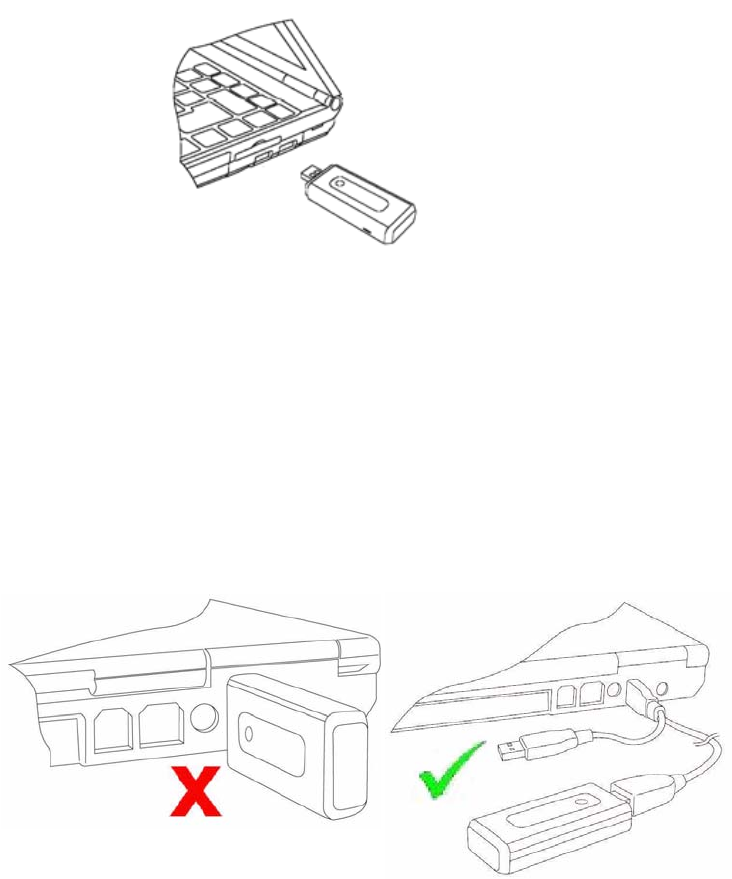
DRAFT
Overview 5
Direct connection
The MD300 can be plugged directly into a USB port as shown below. This configuration offers the
best portability.
Note:
To avoid damage to the MD300 or your laptop’s USB port, remove the MD300 before placing
your laptop into a carrying case.
Caution!
Different laptops have different USB port configurations that may conflict with operation. Use
the included extension cable if:
• The USB ports are close together and the modem covers an adjacent port that is needed.
• The modem can not be plugged in directly, e.g., the USB port is recessed and the USB
connector on the modem can not reach.
• The USB port is in a position where physical pressure is put on the connector as shown
below.
Extension Cable
The extension cable provided is specially designed to work with your MD300. This is a high quality
USB cable that is capable of delivering high current to the MD300 when necessary.
Note:
Do not use standard USB cables between your MD300 and a USB port.
The extension cable has two USB plugs. Plug A carries both data and power and plug B carries power
only.
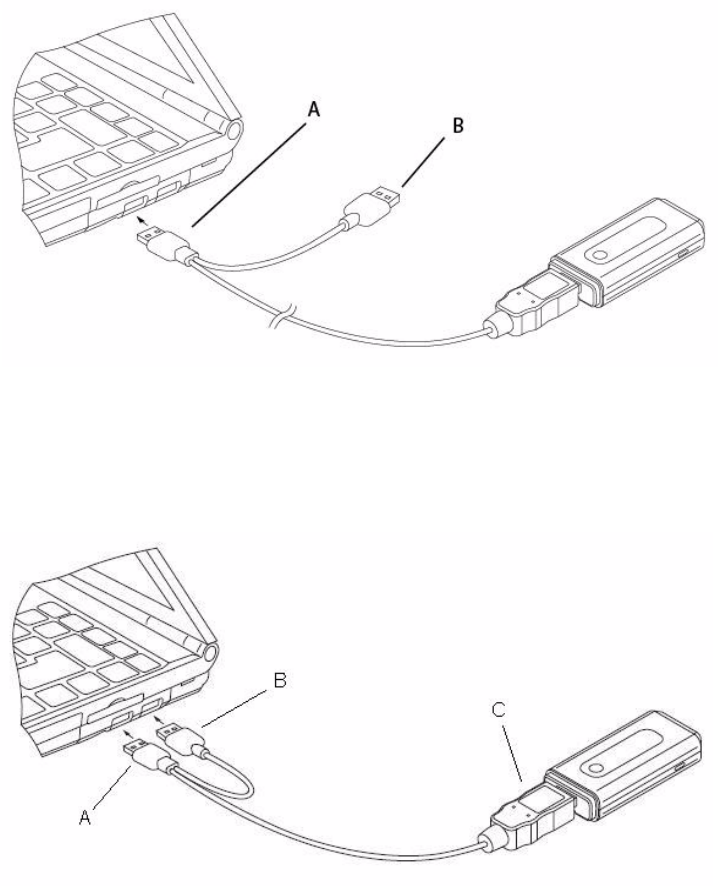
DRAFT
6Overview
Using one plug
When using the one plug configuration, plug A must be used.
Using two plugs
The extension cable provided with the MD300 has two USB plugs. When both plugs are used,
current can be drawn from two USB ports. For more information on power considerations, refer to
Power Considerations on page 4.
This configuration provides maximum power for all environments.
Important!
Both USB plugs must be inserted into the same PC or hub. Do not insert the two USB plugs
into two separate devices.
Note:
If the Windows USB Device Not Configured error message displays, fully disconnect your
MD300 and then reconnect it.
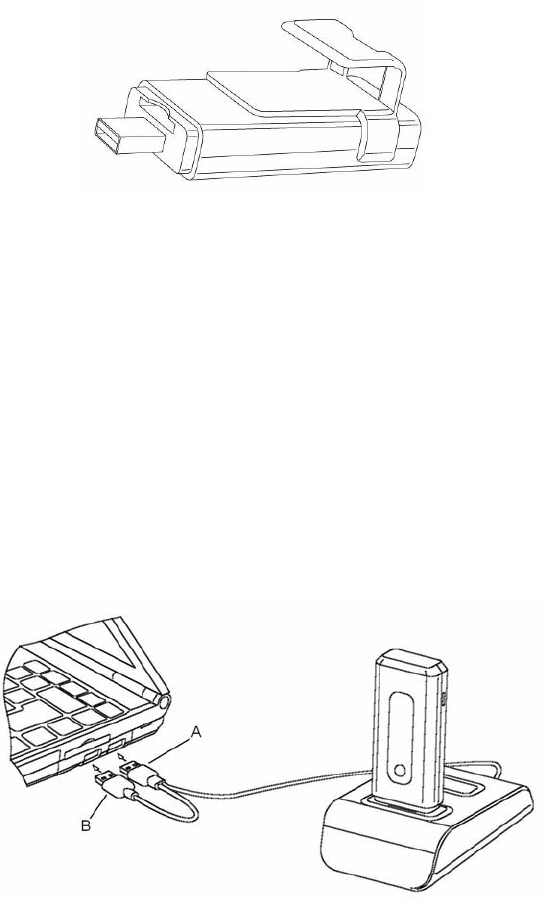
DRAFT
Overview 7
Mounting Clip
The MD300 comes with a mounting clip that can be installed on the MD300, as shown below.
With the extension cable and mounting clip installed, MD300 can then be hooked on the laptop
screen.
Desk Stand
An accessory desk stand (CDS-300) is available for use with your MD300. The desk stand is ideal
for use with a desktop PC, making it easy to unplug and take the MD300 away for use with a laptop.
The desk stand also allows you to reposition the MD300 around your work area and it orients the
MD300 into the optimal position for reception. The desk stand has a high quality cable with two USB
plugs (A and B). One or both USB plugs can be used, refer to Extension Cable on page 5 for more
information.
Important!
Both USB plugs must be inserted into the same PC or hub. Do not insert the two USB plugs
into two separate devices.
The cap of the MD300 can be clipped to the desk stand for safe storage.
Powered Hub
A self powered hub (not provided) may be used in conjunction with the extension cable or desk stand
and your MD300. In some cases, especially when used with desktop PCs, it may be necessary to plug
the MD300 into a USB hub rather than directly into the PC. This is possible, provided that the hub
is self powered via its own AC adaptor. One or both USB plugs can be used, refer to Extension Cable
on page 5 for more information.
Note:
It is not advisable to use a bus-powered hub with your MD300. These are hubs that have no
power supply of their own. Many portable hubs for laptops are of this type.
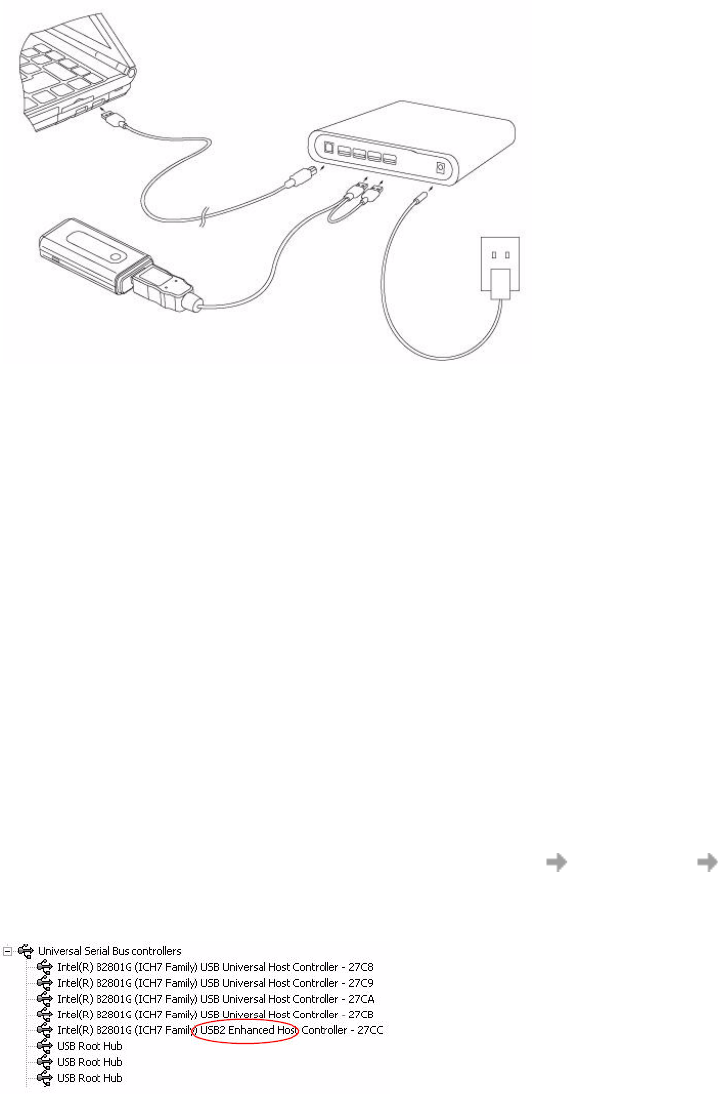
DRAFT
8Overview
The MD300 is plugged in using the supplied extension cable or directly in to a socket on the hub.
The hub configuration allows extended cable length so you can locate the MD300 for optimal
reception.
Note:
Some powered hubs may not provide adequate power. Your hub must be capable of
supporting high power USB devices and must not be overloaded by the connection of too
many such devices. Other high power devices include USB-powered disk drives, scanners
and rechargeable music players. If you are experiencing problems, unplug these other devices
to test if your hub is overloaded.
USB 1.1 and 2.0
Your MD300 is a USB 2.0 product, however it should work in the majority of USB 1.1 ports. In both
cases, communication with the MD300 is USB High Speed, up to 12Mbps, which is more than
sufficient to handle the 3.6Mbps HSDPA throughput.
As a guide, USB 1.1 ports are likely to be found in these cases:
•All PCs manufactured before 2002
•All PCs originally sold with Windows 2000 installed
•Current PCs where the USB port is provided only for use with keyboard and mouse.
USB 2.0 ports can be identified in the Device Manager. Select Start Control Panel System,
Hardware Tab, Device Manager.
The presence of an Enhanced Host Controller indicates USB 2.0 support:
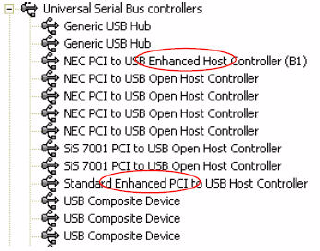
DRAFT
Overview 9
Software overview
Sony Ericsson Wireless Manager
Sony Ericsson provides Wireless Manager, an application that provides the ability to configure and
manage your wireless connections on your PC. For more information about software requirements,
refer to the Wireless Manager User Guide.
You can use Wireless Manager to:
• Connect to the Internet or your corporate network
• Display mobile network status information
• Create or modify connection settings
• Manage your MD300 settings and preferences
• Send and receive SMS messages
• Manage phonebooks saved to your SIM card and hard drive
launch2net - Sony Ericsson Edition
To use your MD300 with your Mac OS X system, you will need launch2net – Sony Ericsson
Edition. This application enables you to set up and use UMTS/HSDPA and GPRS/EDGE
connections (subject to network coverage and availability). The software is available for download
without charge from this Website:
www.novamedia.de/sonyericsson
Please follow the instructions on the Website to install, configure, and use your MD300 with your
Apple PowerBook, MacBook iMac and MacPro. Do not use the Quick Start Guide that is included
with the Sony Ericsson Mobile Broadband USB Modem. For more information, refer to
documentation that comes with the launch2net – Sony Ericsson Edition application.
Third-party applications
Your network operator or your network administrator may provide an application that works with
your MD300. Please refer to the instructions supplied with that application. Functions and features
available may be different compared with the Sony Ericsson Wireless Manager application.

DRAFT
10 Overview
Virtual Private Network (VPN)
Your MD300 is tested for compatibility with popular VPN solutions used by corporations to enable
remote workers to access the corporate network.
Note:
Sony Ericsson does not provide any VPN software with your MD300.
System requirements
This section lists the hardware and software requirements for using your MD300.
General
You will need the following hardware:
• Available USB port capable of supporting high power USB devices
• MD300
• SIM card
Windows (Wireless Manager)
Wireless Manager works with the following versions of the Windows® operating system:
• Windows 2000 Service Pack 4 (SP4)
• Windows XP Service Pack 2 (SP2); 32-bit (x86) and 64-bit (x64) processors
• Windows Vista™; 32-bit (x86) and 64-bit (x64) processors
Your laptop PC must meet or exceed the minimum system requirements for the installed version of
the Windows operating system and have the following:
• 110MB of available disk space
or
300MB of available disk space if install package is downloaded to your PC
Note:
Sony Ericsson periodically releases new versions of Wireless Manager with new features and
bugfixes. The exact support for the Windows Operating System may change over time. The
readme.txt file included in the download, always identifies which versions and service packs
of the Windows operating system are supported. For more information and downloads, please
visit www.sonyericsson.com/support
Apple Macintosh
Please refer to the instructions suppled with launch2net or other application software.
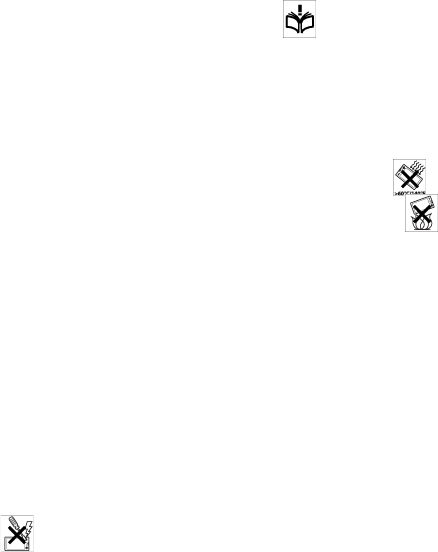
DRAFT
Additional information 11
Additional information
Guidelines for safe and efficient use
Please read this information before using your MD300.
Recommendations
• Always treat your product with care and keep it in a clean and dust-free place.
• Do not expose your product to liquid, moisture or humidity.
• Do not expose your product to extreme high or low temperatures.
• Do not expose your product to open flames or lit tobacco products.
• Do not drop, throw or try to bend your product.
• Do not paint your product.
• Do not use your product near medical equipment without requesting permission from your
treating physician or authorised medical staff.
• Do not use your product when in, or around aircraft, or areas showing the sign “turn off two-
way radio”.
• Do not use your product in an area where a potentially explosive atmosphere exists.
• Do not place your product or install wireless equipment in the area above your car’s air bag.
• Do not attempt to disassemble your product. Only Sony Ericsson authorised personnel should
perform service.
Efficient use
Do not cover the MD300 when in use, as this affects call quality.
Radio Frequency (RF) exposure and SAR
Your Sony Ericsson MD300 is a low-power radio transmitter and receiver (transceiver). When it
is turned on, it emits low levels of radio frequency energy (also known as radio waves or radio
frequency fields).
Governments around the world have adopted comprehensive international safety guidelines, developed
by scientific organizations, e.g. ICNIRP (International Commission on Non-Ionising Radiation Protection)
and IEEE (The Institute of Electrical and Electronics Engineers Inc.), through periodic and thorough
evaluation of scientific studies. These guidelines establish permitted levels of radio wave exposure
for the general population. The levels include a safety margin designed to assure the safety of all
persons, regardless of age and health, and to account for any variations in measurements.
Specific Absorption Rate (SAR) is the unit of measurement for the amount of radio frequency energy
absorbed by the body when using a transceiver. The SAR value is determined at the highest certified
power level in laboratory conditions, but the actual SAR level of the transceiver while operating can
be well below this value. This is because the transceiver is designed to use the minimum power required
to reach the network.

DRAFT
12 Additional information
Variations in SAR below the radio frequency exposure guidelines do not mean that there are variations
in safety. While there may be differences in SAR levels among mobile phones, all Sony Ericsson
modems are designed to meet radio frequency exposure guidelines.
More information on radio frequency exposure and SAR can be found on:
www.sonyericsson.com.
Personal medical devices
Modems may affect the operation of cardiac pacemakers and other implanted equipment. If a minimum
distance of 15 cm (6 inches) is kept between the MD300 and the pacemaker, the risk of
interference is limited. If you have any reason to suspect that interference is taking place,
immediately turn off your MD300. Contact your cardiologist for more information.
For other medical devices, please consult your physician and the manufacturer of the device.
Children
DO NOT ALLOW CHILDREN TO PLAY WITH YOUR MD300. THEY COULD HURT
THEMSELVES OR OTHERS, OR COULD ACCIDENTALLY DAMAGE THE MODEM. YOUR
MODEM MAY CONTAIN SMALL PARTS THAT COULD BE DETACHED AND CREATE A
CHOKING HAZARD.
Disposal of old electrical & electronic equipment
This symbol indicates that all electrical and electronic equipment included shall not be treated as
household waste. Instead it shall be left at the appropriate collection point for the recycling of
electrical and electronic equipment. By ensuring this product is disposed of correctly, you will
help prevent potential negative consequences for the environment and human health, which could
otherwise be caused by inappropriate waste handling of this product. The recycling of materials will
help to conserve natural resources. For more detailed information about recycling of this product,
please contact your local city office, your household waste disposal service or the shop where you
purchased your MD300.
Emergency calls
Mobile Broadband Modems manufactured by Sony Ericsson do not support voice calls and should
not be relied upon for essential communications.
Inserting and removing the SIM card – precautions against electrostatic discharge (ESD)
Do not touch the SIM card connectors. As a precaution, always make sure that the MD300 is already
in your hand before you insert or remove the SIM card.
DRAFT
Additional information 13
Generic SEMC Limited warranty
Limited Warranty
Sony Ericsson Mobile Communications AB, Nya Vattentornet, SE-221 88 Lund, Sweden,
(Sony Ericsson) or its local affiliated company, provides this Limited Warranty for your mobile
phone, original accessory delivered with your mobile phone, and/or your mobile computing product
(hereinafter referred to as "Product").
Should your Product need warranty service, please return it to the dealer from whom it was
purchased, or contact your local Sony Ericsson Call Center (national rates may apply) or visit
www.sonyericsson.com to get further information.
Warranty requirements may differ by country or region. Please visit www.sonyericsson.com/support
to review the Sony Ericsson warranty applicable to the country or region where you purchased your
product, which may differ from the default generic warranty included with your user materials.
OUR WARRANTY
Subject to the conditions of this Limited Warranty, Sony Ericsson warrants this Product to be free
from defects in design, material and workmanship at the time of its original purchase by a consumer.
This Limited Warranty will last for a period of one (1) year as from the original date of purchase of
the Product.
WHAT WE WILL DO
If, during the warranty period, this Product fails to operate under normal use and service, due to
defects in design, materials or workmanship, Sony Ericsson authorized distributors or service
partners, in the country* where you purchased the Product, will, at their option, either repair or
replace the Product in accordance with the terms and conditions stipulated herein.
Sony Ericsson and its service partners reserve the right to charge a handling fee if a returned Product
is found not to be under warranty according to the conditions below.
Please note that some of your personal settings, downloads and other information may be lost when
your Sony Ericsson Product is repaired or replaced. At present Sony Ericsson may be prevented by
applicable law, other regulation or technical restrictions from making a backup copy of certain
downloads. Sony Ericsson does not take any responsibility for any lost information of any kind and
will not reimburse you for any such loss. You should always make backup copies of all the
information stored on your Sony Ericsson Product such as downloads, calendar and contacts before
handing in your Sony Ericsson Product for repair or replacement.
CONDITIONS
1. This Limited Warranty is valid only if the original proof of purchase for this Product issued by a
Sony Ericsson authorized dealer specifying the date of purchase and serial number**, is
presented with the Product to be repaired or replaced. Sony Ericsson reserves the right to refuse
warranty service if this information has been removed or changed after the original purchase of
the Product from the dealer.
2. If Sony Ericsson repairs or replaces the Product, the repair for the defect concerned, or the
replaced Product shall be warranted for the remaining time of the original warranty period or for
ninety (90) days from the date of repair, whichever is longer. Repair or replacement may involve
the use of functionally equivalent reconditioned units. Replaced parts or components will
become the property of Sony Ericsson.
DRAFT
14 Additional information
3. This warranty does not cover any failure of the Product due to normal tear and wear, or due to
misuse, including but not limited to use in other than the normal and customary manner, in
accordance with the Sony Ericsson instructions for use and maintenance of the Product. Nor
does this warranty cover any failure of the Product due to accident, software or hardware
modification or adjustment, acts of God or damage resulting from liquid.
A rechargeable battery can be charged and discharged more than a hundred times. However, it
will eventually wear out - this is not a defect and corresponds to normal wear and tear. When the
talk-time or standby time is noticeably shorter, it is time to replace your battery. Sony Ericsson
recommends that you use only batteries and chargers approved by Sony Ericsson.
Minor variations in display brightness and colour may occur between the phones. There may be
tiny bright or dark dots on the display. These are called defective pixels and occur when
individual dots have malfunctioned and can not be adjusted. Two defective pixels are deemed
acceptable.
Minor variations in camera image appearance may occur between phones. This is nothing
uncommon and is not regarded as a defective camera module.
4. Since the cellular system on which the Product is to operate is provided by a carrier independent
from Sony Ericsson, Sony Ericsson will not be responsible for the operation, availability,
coverage, services or range of that system.
5. This warranty does not cover Product failures caused by installations, modifications, or repair or
opening of the Product performed by a non-Sony Ericsson authorised person.
6. The warranty does not cover Product failures which have been caused by use of accessories or
other peripheral devices which are not Sony Ericsson branded original accessories intended for
use with the Product.
7. Tampering with any of the seals on the Product will void the warranty.
8. THERE ARE NO EXPRESS WARRANTIES, WHETHER WRITTEN OR ORAL, OTHER
THAN THIS PRINTED LIMITED WARRANTY. ALL IMPLIED WARRANTIES,
INCLUDING WITHOUT LIMITATION THE IMPLIED WARRANTIES OF
MERCHANTABILITY OR FITNESS FOR A PARTICULAR PURPOSE, ARE LIMITED TO
THE DURATION OF THIS LIMITED WARRANTY. IN NO EVENT SHALL Sony Ericsson
OR ITS LICENSORS BE LIABLE FOR INCIDENTAL OR CONSEQUENTIAL DAMAGES
OF ANY NATURE WHATSOEVER, INCLUDING BUT NOT LIMITED TO LOST PROFITS
OR COMMERCIAL LOSS; TO THE FULL EXTENT THOSE DAMAGES CAN BE
DISCLAIMED BY LAW.
Some countries/states do not allow the exclusion or limitation of incidental or consequential
damages, or limitation of the duration of implied warranties, so the preceding limitations or
exclusions may not apply to you.
The warranty provided does not affect the consumer's statutory rights under applicable legislation in
force, nor the consumer's rights against the dealer arising from their sales / purchase contract.
*GEOGRAPHICAL SCOPE OF THE WARRANTY
If you have purchased your Product in a country member of the European Economic Area (EEA) or
in Switzerland or the Republic of Turkey, and such Product was intended for sale in the EEA or in
Switzerland or in Turkey, you can have your Product serviced in any EEA country or in Switzerland
or in Turkey, under the warranty conditions prevailing in the country in which you require servicing,
provided that an identical Product is sold in such country by an authorised Sony Ericsson distributor.
DRAFT
Additional information 15
To find out if your Product is sold in the country you are in, please call the local Sony Ericsson Call
Center. Please observe that certain services may not be possible elsewhere than in the country of
original purchase, for example due to the fact that your Product may have an interior or exterior
which is different from equivalent models sold in other countries. Please note in addition that it may
sometimes not be possible to repair SIM-locked Products.
** In some countries/regions additional information (such as a valid warranty card) may be
requested.

DRAFT
16 Technical specifications
Technical specifications
General
Exterior description
Ambient temperatures
Environmental Compliance
Product name MD300
System GSM 850
E-GSM 900
GSM 1800
GSM 1900
UMTS 850
UMTS 1900
UMTS 2100
USB Device Type USB 2.0 High Power, Full Speed
Services supported GSM: GPRS/EDGE, SMS, USSD
UMTS: Packet-Switched, HSDPA, Circuit-Switched, SMS, USSD
Speech services are not supported
SIM Card Small plug-in card, 3V and 1.8V type
Regular (non-GPRS-aware) and GPRS-aware SIMs supported
USIM
Type Number FAD-3232021-BV
Size Length: 70mm not including USB connector
Width: 33mm
Height: 14.5mm
Weight 30g, excluding cap and SIM card
Battery Powered via the USB port.
Antenna GSM/UMTS antenna integrated in to the device
Operating -10 to 55 degrees C
Storage -20 to 65 degrees C
Directives WEEE (Waste Electrical and Electronic Equipment Directive)
RoHS (Restriction of use of certain Hazardous Substances)

DRAFT
Technical specifications 17
Application support
Electrical characteristics
Note:
All power consumptions are at nominal voltage.
GSM performance and technical characteristics
GSM features supported
Windows Sony Ericsson Wireless Manager
Third-party software that might be provided by your mobile operator
Apple Macintosh launch2net - Sony Ericsson Edition (via download)
Third-party software that might be provided by your mobile operator
Nominal operating voltage 5V
Average Idle Power (GPRS attached) < 250mW
Data Transfer Power (Worst case) < 2.9W
Dimension GSM 850 GSM 900
E-GSM 900 GSM 1800 GSM 1900
Modulation GMSK/8-PSK GMSK/8-PSK GMSK/8-PSK GMSK/8-PSK
Power classes Class 4 (2W) for GSM/
GPRS and EGPRS/MCS
1-4 (GMSK);
Class E2 (0.5W) for
EGPRS/MCS 5-9 (8-
PSK)
Class 4 (2W) for GSM/
GPRS and EGPRS/MCS
1-4 (GMSK);
Class E2 (0.5W) for
EGPRS/MCS 5-9 (8-
PSK)
Class 1 (1W) for GSM/
GPRS and EGPRS/MCS
1-4 (GMSK);
Class E2 (0.4W) for
EGPRS/MCS 5-9 (8-PSK)
Class 1 (1W) for GSM/
GPRS and EGPRS/MCS
1-4 (GMSK);
Class E2 (0.4W) for
EGPRS/MCS 5-9 (8-PSK)
ME SIM Lock Network
Network Subset
Service Provider
Corporate
Online services (SIM-AT) Supported (R99)
USIM Application Toolkit Supported via AT Commands No MMI is provided
USSD Phase 2+
Support is provided via AT commands; No MMI is provided
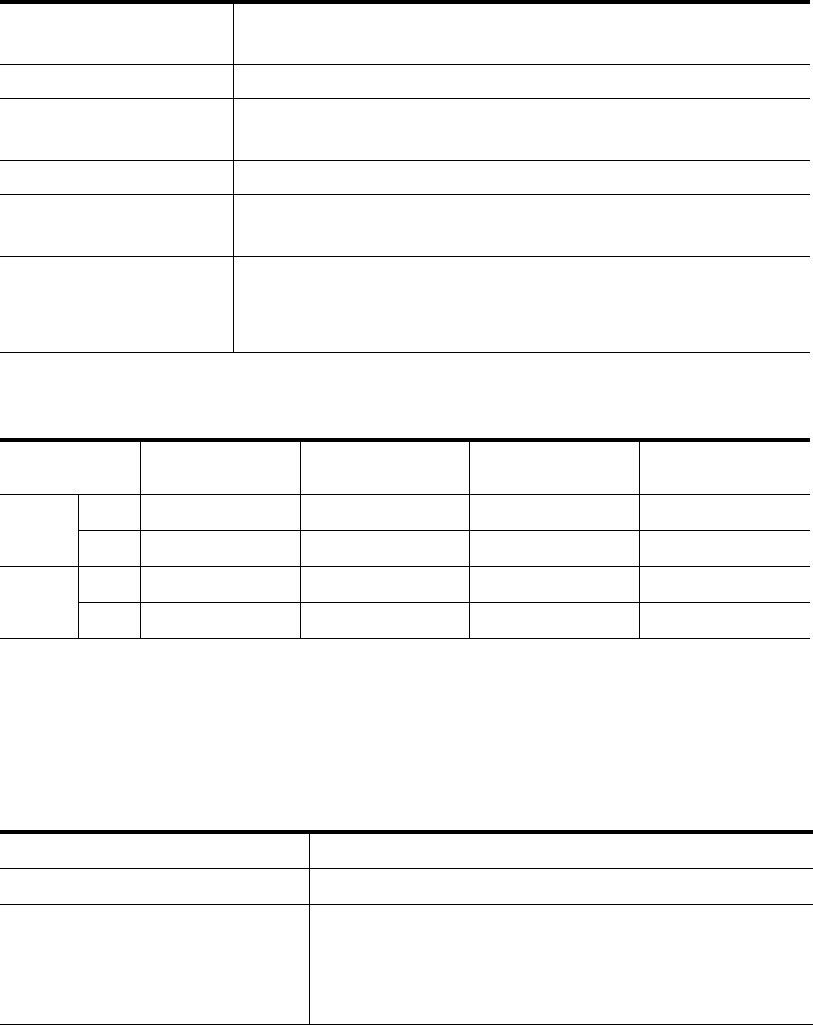
DRAFT
18 Technical specifications
GPRS technical data
GPRS maximum data rates
Speed achieved depends on the Coding Scheme supported by the GSM network. The speeds given
are maxima. Sony Ericsson cannot guarantee the speed at which your network will operate.
Data rate is the payload per slot: header plus data.
EDGE technical data
Data Rates Multislot class 10 supported (see table below).
Coding schemes: CS-1, CS-2, CS-3 and CS-4
Mode of Operation Class B (attaches to both GSM and GPRS at the same time).
IP Connectivity PDP type IP is supported
IPv4
SMS over GPRS Mobile Originated and Mobile Terminated
Compression TCP/IP Header Compression (RFC1144 and RFC 2507)
V42bis
GPRS Encryption GEA1 and GEA2
GPRS IP allocation Dynamic
Static
CS-1
9.05 kbps CS-2
13.4 kbps CS-3
15.6 kbps CS-4
21.4 kbps
4 + 1 RX 36.2 53.6 62.4 85.6
TX 9.05 13.4 15.6 21.4
3 + 2 RX 27.15 40.2 46.8 64.2
TX 18.1 26.8 31.2 42.8
Device class EDGE Class 10
Modulation Coding Schemes MCS-1 to MCS-9
EDGE features Link Adaptation
Incremental Redundancy
Extended Uplink Temporary Block Flow (TBF)
Network Assisted Cell Change (NACC)

DRAFT
Technical specifications 19
EDGE maximum data rates
Speed achieved depends on the Coding scheme supported by the GSM Network. The speeds given
are maxima, Sony Ericsson cannot guarantee the speed at which your network will operate.
Data rate is the payload per slot: header plus data.
UMTS technical data
HSDPA technical data
4 + 1 3 + 2
Coding scheme Data rate per slot Rx Tx Rx Tx
MCS-1 10.60 42.40 10.60 31.80 21.20
MCS-2 13.00 52.00 13.00 39.00 26.00
MCS-3 16.60 66.40 16.60 49.80 33.20
MCS-4 19.40 77.60 19.40 58.20 38.80
MCS-5 24.05 96.20 24.05 72.15 48.10
MCS-6 31.25 125.00 31.25 93.75 62.50
MCS-7 47.45 189.80 47.45 142.35 94.90
MCS-8 57.05 228.20 57.05 171.15 114.10
MCS-9 61.85 247.40 61.85 185.55 123.70
Power class Class 3 (0.25W, 24dBm)
Maximum Downlink speed 384kbps
Maximum Uplink speed 384kbps
UMTS features Inter-Mode Handover (UMTS/EDGE/GPRS)
Inter-Mode Reselection (UMTS/EDGE/GPRS)
Quality Of Service UMTS classes supported via AT Command
Modes PDP type IP is supported
IPv4
IP Allocation Static, Dynamic
R4 Enhancements Extended TBF Uplink
Network Assisted Cell Change (NACC)
Maximum Downlink speed 3.6Mbps
HSDPA Categories 1-6, 11, 12

DRAFT
20 Technical specifications
SMS Technical Data
Firmware upgrade
Software upgrade
Flash memory drive
Concatenated SMS Supported in Wireless Manager or via third party software
SMS Cell Broadcast Supported via AT Commands.
SMS interface Wireless Manager.
AT Command.
MD300 firmware upgrade Via secure Internet download using the Sony Ericsson Update Service,
www.sonyericsson.com/support or at Sony Ericsson Service Points
Wireless Manager Upgrade Internet download
Flash Memory Drive (USB Mass Storage) 1
1. Exact capacity depends upon the firmware and software installer. In Wireless Manager, go to Settings >
Flash Memory where you can free up space by saving the software installer files to you hard drive. You
can also copy the installer back to your MD300, for example, to allow another user to easily install and
use your MD300.
Drive capacity >= 128 MB
DRAFT
Index 21
Index
A
Apple
Mac OS X 9
C
Configurations 4
desk stand 7
direct USB connection 5
powered hub 7
using the Y-cable 6
D
declaration of conformity v
E
EDGE
definition 2
maximum data rates 19
technical data 18
F
FCC vi
firmware 20
firmware upgrade 20
G
GPRS
definition 2
maximum data rates 18
technical data 18
GSM
features supported 17
performance 17
guidelines
children 12
emergency calls 12
overview 11
personal medical devices 12
recommendations 11
RF exposure and SAR 11
SIM handling 12
H
hardware
overview 2
requirements 10
SIM card 3
HSDPA
definition 1
technical data 19
I
Internet 20
L
launch2net – Sony Ericsson Edition 9
M
Mobile Broadband Modem
disposal of 12
N
network
requirements 4
P
packaging, checklist 1, 2
personal medical devices, guidelines 12
R
requirements
hardware 10
network and subscription 4
RF exposure 11
S
SAR 11
SIM Card
guidelines 12
SIM card 3
SMS
definition 2
technical data 20
DRAFT
22 Index
software
Apple Macintosh 9
launch2net – Sony Ericsson Edition 9
overview 9
third-party applications 9
Wireless Manager 9
specifications 16
support
Sony Ericsson Website vii
T
technical specifications 16
third-party applications 9
U
UMTS
definition 1
technical data 19
V
VPN 10
W
warranty
limited 13
Wireless Manager
description 9